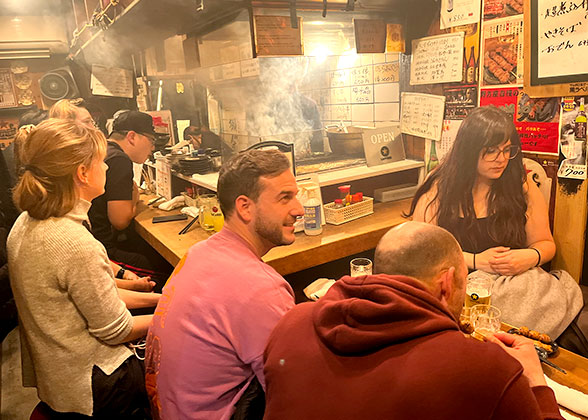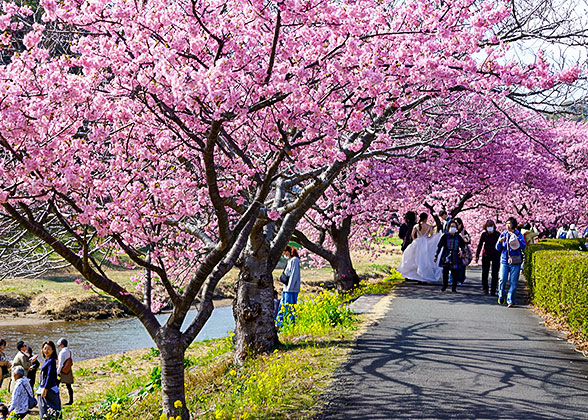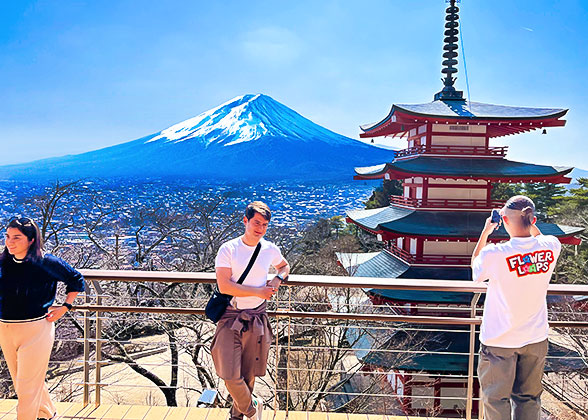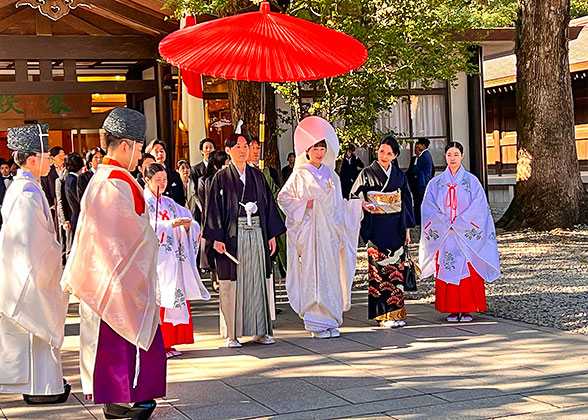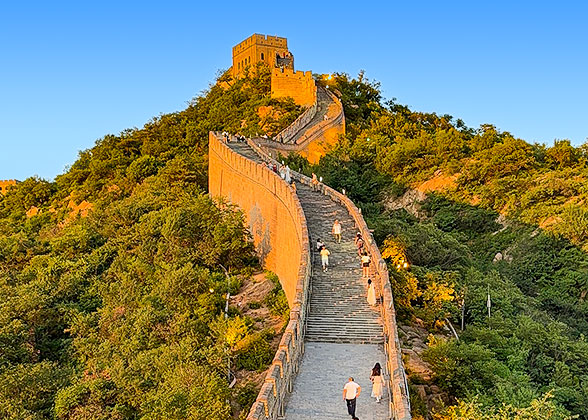Day 1: Tokyo Airport Pick-up by Shared Car
Welcome to Japan! After landing in Tokyo, you’ll meet our English-speaking assistant, who will greet you with a paging board and guide you to the shared car that will take you to the hotel. ★ Airport Transfer by Shared Car: Smart Choice of Us, Real Savings for You!Considering Tokyo’s airports’ long distance from downtown and Japan’s high labor costs, we prioritize shared car for our guests, the most cost-effective for USD 105 per person, compared to other operators’ compulsory private car transfer costing USD 300+, which is best suited for groups of 7 or more. For a more economical way, consider the Narita Airport Limousine Bus or JR trains (2 hours, USD 24 per person), and it would be more affordable and faster from the closer Haneda Airport. The convenient and comfortable taxis, with 5 and 7-seat options and costing about USD 200, are recommended for 3 or more companions. Whether you prefer a budget-friendly transport or want to upgrade to a private car for an additional fee, we’re always glad to help you find the perfect fit. ► Recommendations for Early Arrivals With our well-selected hotel ideally located in Shinjuku, if you feel refreshed after a rest, just take a stroll to explore this popular business district of Tokyo. A 10-minute walk will bring you to Kabukicho, a lively and charming scene at night where dazzling neon signs lining the streets might remind you that this is Asia’s largest red-light district. However, don’t be surprised or alarmed; Japan is world-renowned for its safety if you follow the rules. Ready for a bite? Use the app Gurunavi or Tabelog to discover nearby hidden restaurant gems with authentic reviews, such as Jojoen Shinjuku Central East Exit Branch for high-quality Japanese beef yakiniku, and Sushi Zanmai, an affordable 24-hour sushi chain, along with a variety of other delicacies like yakitori, tempura, ramen, and sukiyaki. If you’re seeking a deeper exploration, venture into the narrow, dimly lit alley of Omoide Yokocho, which conceals the true soul of Japan in small izakayas, where you can enjoy a drink to unwind after a day of travel. ► Our Expert Advice on Money Exchange It is advisable to exchange cash in Tokyo rather than in other cities with less favorable rates, and cash is commonly used in traditional restaurants and markets. Avoid exchanging money at airports or hotels due to poor rates, typically around USD 1 to JPY 120. Our July 2025 field survey reveals the best rates are found at currency exchange shops near Exit D3 of Shinjuku Nishiguchi subway station. Check out ‘Ninja Money Exchange’ and ‘ACCESS TICKET Shinjuku Nishiguchi’ for rates around USD 1 to JPY 144. Avoid ‘Amazon’ in the middle, as it charges an 8% commission. If you’re too busy to go there, you can withdraw cash directly from ATMs at convenience stores like Family Mart, Lawson, and 7-Eleven, using VISA or MasterCard, which also offer reasonable rates. ► Why We Recommend a Private Guide & Public Transportation in Japan Navigating Japan’s unique language and culture can be a challenge. That’s why we arrange for a local private guide to help you bridge language barriers and cultural gaps. The experienced guide knows the best routes, maximizes your visit, and offers in-depth explanations allowing you to fully appreciate the historical and artistic essence of each site, along with insider food tips. Since most of Japan’s attractions are easily reached by public transportation or on foot, our expertly-designed itinerary makes full use of convenient rail transit instead of costly private cars or taxis, helping you save as much as possible. Beyond being punctual, traffic-free, and eco-friendly, rail travel seamlessly integrates you into local life, offering an authentic cultural experience. Just note that many attractions involve much walking and gravel paths, so be sure to wear comfortable shoes. Accommodation: Hotel Century Southern Tower, Tokyo (4 stars) or similar
|
Day 2: Tokyo City Tour: Meiji Jingu Shrine, Imperial Palace, National Museum, Senso-ji Temple
After breakfast, your guide will greet you at the hotel lobby and accompany you on a metro ride to the Meiji Jingu Shrine. Walk along the serene worshipper’s path, flanked by dense forests, to approach the main hall built in honor of Emperor Meiji (1852 - 1912), who significantly influenced Japan’s industrialization. In addition to appreciating the Shinto shrine architecture, you may witness an unforgettable traditional Japanese wedding - a parade of guests walking behind the bride and groom through the courtyard at a slow, quiet pace, creating a solemn atmosphere that stands in stark contrast to the excitement of weddings elsewhere in the world. Stay until the end, and you might catch a subtle smile from the couple as they bid farewell to their guests. Later, we’ll proceed to the Imperial Palace, the residence of the Japanese Emperor and imperial family. Instead of a standard tour of the outer gardens typically offered by some travel agencies, we will enjoy an extraordinary in-depth exploration of the inner Fukiage Garden or the East Gardens when the inner garden is closed. While strolling along the scenic moat and capturing stunning photos of the elegant Niju-bashi Bridge, listen to your knowledgeable guide explain the history and architecture of this classic Japanese palace from the 20th century. The next stop is the Tokyo National Museum, where you’ll be captivated by exquisite exhibits ranging from over 10,000 BC to the 19th century in the Japanese Gallery. Take a closer look at the ancient carvings, ceramics, screens, calligraphy paintings, and swords while examining the precious cultural relics from China, India, Korea, and Cambodia in the Asian Gallery to gain insight into the rich history of Oriental civilization. Don’t miss Tohaku’s screen painting ‘Pine Trees’. With just a few strokes, this national treasure evokes the ethereal mist of a pine forest, making it a true pinnacle of Japanese ink painting. Later, follow your guide to explore Asakusa, Tokyo’s most lively traditional neighborhood, with Senso-ji Temple at its heart. Enter through the iconic Kaminarimon Gate, stroll down the bustling Nakamise-dori Street filled with small shops offering a variety of tempting food, crafts, and souvenirs, until you finally reach the Senso-ji Temple, which differs a lot from what you may envision as a secluded, solemn, and austere temple in traditional Oriental settings. In contrast, its main hall, five-story pagoda, and various gates within the temple complex are adorned in bright vermilion. Since the 17th century, Nakamise-dori Street and its surrounding areas have become a hub of entertainment for Tokyo residents. Today, it continues to thrive with a leisure and shopping atmosphere, and even the temple’s Omikuji fortune slips have evolved into a profitable activity. While undeniably intriguing, this blend of entertainment and commercialization prompts reflection on how it aligns with Senso-ji Temple’s original purpose as a sanctuary for worship and prayer. ► From the temple grounds, you’ll catch a glimpse of the towering Tokyo Skytree in the distance. If time permits, come with your guide to explore the back alleys around Senso-ji and the nearby Sumida River, along with a bridge and the riverside Sumida Park, which features a breathtaking spectacle of dreamy pink and cloud-like cherry blossoms in March and April. Finally, the guide will either escort you back to the hotel or drop you off at the popular alley Omoide Yokocho near your hotel if you’d like to continue your evening. Meals: Breakfast Accommodation: Hotel Century Southern Tower, Tokyo (4 stars) or similar
|
Day 3: Mt. Fuji Pilgrimage in Hakone: Owakudani Valley & Lake Ashi Cruise
Mount Fuji Today highlights your Japan tour with a visit to the iconic Mount Fuji, one of the largest active volcanoes in the world. In the morning, your private guide will join you for a bullet train ride to Odawara Station. Then, we’ll continue to Hakone by mountain train, cable car, and ropeway to visit the volcanic scenery of Owakudani Valley. Next, keep riding the ropeway with your guide to Togendai Port. Let’s embark on a relaxing 20-minute cruise aboard a pirate ship on Lake Ashi, feeling the gentle wind through your fingertips and hair while admiring snow-capped Mt. Fuji from various angles. Many mountains in Japan are associated with genders. Do you think Mt. Fuji is considered male for its majestic volcanic power or female for its graceful shape? Actually, Mt. Fuji’s gender is determined by its tutelary deity. After the enormous eruption of Mt. Fuji between 290 and 215 BC, the 11th Japanese Emperor prayed to the fire-controlling deity Asama-no-Okami, the daughter of the mountain god Ouyamatsumi, to suppress the volcanic activity. Following that, Mt. Fuji calmed down significantly and was thus deified as female, the physical embodiment of the goddess Asama-no-Okami. After all the visits today, the guide will escort you back to Tokyo on an express train. ★ Unique Service: Flexible Day to Visit Mt. FujiWe are the first Japan tour operator to offer this service. Recognizing that the Fuji area frequently experiences overcast and rainy weather, and that visitors want to see Mt. Fuji, we offer flexibility for your Mt. Fuji visit to ensure the best possible experience. You can discuss the schedule with your guide and prioritize visiting Mt. Fuji on a clear day. However, be prepared for challenges if you choose a flexible date. Reserved tickets for express or bullet trains often sell out a month in advance, so you may have to endure a no-seat train ride, but the risk is only 5% in the off-season. Also, be aware that even if you change the date, unpredictable weather may still obscure the mountain view. We successfully help over 100 high-end customized tour guests view Mount Fuji each year by monitoring the Mt. Fuji visibility index forecast and adjusting the itinerary as needed. You can read about their enjoyable experiences and gratitude in our reviews on TripAdvisor or TourRadar. Meals: Breakfast Accommodation: Hotel Century Southern Tower, Tokyo (4 stars) or similar
|
Day 4: Tokyo to Kyoto: Golden Pavilion, Nijo Castle, Pure Water Temple & Gion, Geisha Show
This morning, you’ll experience the efficiency of Japan’s bullet train while traveling independently from Tokyo to Kyoto. The guide will provide your reserved-seat train tickets in advance. Please leave your hotel at least 30 minutes before your train’s scheduled departure. Walk 1 minute north to Shinjuku Station, and here take either the Chuo Line or Marunouchi Line for 15-20 minutes to Tokyo Station for the bullet train, or take a taxi if you have big luggage. Given the 2.5-hour train ride and the early closing times of many attractions in Japan between 16:00 and 17:00, we’ve scheduled your bullet train to depart round 8:30 AM to give you ample time for sightseeing in Kyoto. Please contact us if you need to adjust the train time. ► Travel Light: Slopes and steps can be frustrating when carrying bulky luggage, and some trains charge extra for oversized bags. If heavy baggage troubles you, consider using a small carry-on bag and ask the guide or hotel staff to deliver the rest to your third destination, allowing 2-3 days for transit. Upon arrival, your guide will greet you at Kyoto Station where you’ll immediately notice the magnificent Kyoto Tower right outside the station, and then accompany you on a cultural tour, delving into this millennium-old former capital of Japan. After checking into the hotel, we’ll first head to the Temple of the Golden Pavilion, where its classical beauty and graceful reflection in the pond will strike you at first glance. The Golden Pavilion was built in 1397 as the residence for Ashikaga Yoshimitsu, who unified Japan five years earlier and thus became the most arrogant general at that time, wielding unmatched power and even making the emperor a mere puppet. After the death of the emperor’s mother, Ashikaga Yoshimitsu had his wife acknowledged as the emperor’s mother and himself as the emperor’s father. Walking around the pavilion, adorned with numerous gold foils and far more splendid than the imperial palace, you can feel Ashikaga Yoshimitsu’s arrogance and ambition. Later, let’s explore the Nijo Castle, built in 1603 and once the residence of Japan’s first Tokugawa shogun. From the viewing platform in the backyard, you can admire its extravagant architecture, which also surpassed the imperial palace of the same period. Take in the serene black tiles and white walls, set against a lush pine forest, with high-rise buildings dotting the distant horizon. Here, you’ll feel the enduring charm of the Tokugawa Shogunate seamlessly merge with modern Kyoto. Next, we’ll explore the old town of Kyoto. Join your guide through a captivating maze of winding ramps and stairways. Strolling along the Sannenzaka Path, meaning the ‘slope for peaceful delivery’ blessing the pregnant women, you’ll arrive at the 1,200-year-old Pure Water Temple. Enter through its Niomon Gate, you’ll be mesmerized by the elegant Three-story Pagoda. Climb the stairs to the Hondo Main Hall, where you’ll witness the enshrined the Eleven-headed Thousand-armed Kannon, aka the Bodhisattva of Compassion. Waves of locals, particularly newlyweds, come to pray here for childbearing, a tradition passed down from ancient times when inadequate medical conditions made safe childbirth a priority for every family. From the hall’s protruding wooden veranda suspended above the cliff, you’ll marvel at the panoramic cityscape brimming with ancient roofs and tower tops, and genuinely appreciate why Kyoto is a UNESCO World Heritage Site and Japan’s spiritual heart. ★ Crowning Touch of Today: Traditional Geisha Tea CeremonyLeave the temple, and follow your guide to a handpicked traditional teahouse for an intriguing geisha show. During one hour, you can try brewing tea while enjoying two dried sweets and matcha green tea. Additionally, enjoy captivating performances by geishas or maikos (apprentice geishas) from Gion or Miyagawa, showcasing traditional dance and a tea ceremony. Seize the rare opportunity to engage in pleasant conversation and take commemorative photos with a maiko. Before leaving, you may receive a senjafuda from a maiko, symbolizing a lucky charm that would bring wealth and prosperity. Pure Water Temple, Kyoto Sannenzaka Alleyway
Next, we’ll continue on a Gion walking tour to experience authentic Kyoto. While wandering through the bustling ramps of Sannenzaka and Ninenzaka lined with Japanese-style wooden houses that sell local snacks, groceries, and souvenirs, stop by the stunning five-story Yasaka Pagoda, a popular landmark offering a fantastic photo opportunity. Capture an unforgettable scene filled with a continuous flow of colorful kimono-clad tourists and locals. If you’re interested, you can also rent a kimono yourself to fully immerse in the atmosphere. Finally, visit the lively Yasaka Shrine, and your guide will then escort you back to the hotel. Alternatively, we highly recommend spending your free time here to enjoy the inviting night view of Gion’s labyrinthine alleyways. ► Top Locations to Encounter Genuine Geishas on Your Own Where is the best place to see geishas? Casual observers might visit the Yasaka Shrine but only encounter tourists in kimonos, while those who have consulted more travel guides will go to Hanamikoji Street. However, our in-the-know travel experts emphasize that the best spot to find authentic geishas is the lesser-known intersection of Hanamikoji Street and Tominagacho Street. Navigating from Yamatooji-dori to Gionto Pharmacy on Google Maps can help you find this area. As you stroll down this narrow east-west alley adorned with lit lanterns, flanked by traditional small restaurants, izakayas, and geisha houses, you can meet many geishas and maikos wearing traditional kimonos and elaborate makeup. From here to your hotel, you can walk to Shijo Keihan-mae Station, take the 207 City Bus for 11 stops (about 23 minutes) to Subway Kujo Station, then walk 3 minutes; or simply take a 15-minute taxi back. Meals: Breakfast Accommodation: Rihga Royal Hotel Kyoto (4 stars) or similar
|
Day 5: Kyoto - Nara - Kyoto: Fushimi Inari Shrine, Nara Park with Deer, Naramachi Lattice House
In the morning, meet your guide at the hotel and head to the Fushimi Inari Shrine, which honors the kami of rice and agriculture, blessing the prosperity of commerce and crops. After watching the locals engage in special worship ceremonies inside the main hall from a well-chosen spot, we’ll ascend the mountain along a striking path beneath a vermilion semi-outdoor space created by thousands of closely spaced and continuous torii gates, called Senbon Torii. Notably, this torii pilgrimage road was constructed not in a unified manner, but rather through a tacit consensus among worshipers as they erected individual torii gates; how amazing! The ideal spot for photos is from the west slope of Mt. Inari, especially to capture the interplay of light and shadows among the torii gates on sunny days. Next, we’ll take the Kintetsu Railway to Nara, the birthplace of ancient Japanese culture with a longer history than Kyoto’s. When thinking of Nara, most people immediately envision its famous residents: the adorable deer, and we’ll spend a relaxing afternoon meeting them in the Nara Park. Over 1,000 deer roam freely in the park, always eager to pose for your camera. If you buy some deer crackers, be ready to be surrounded by a herd of enthusiastic deer, but avoid teasing them with food, or you may be bumped or bitten. Briefly shift your focus from the deer and follow your guide to admire the Five-story Pagoda of the Kofuku-ji Temple from 669 AD, the symbol of Nara. Next, admire the magnificent 15-meter-tall bronze Great Buddha statue at the Great Eastern Temple, built by Emperor Shomu (701 - 756) to ward off disasters and pray for peace and prosperity for the nation. Afterward, as we stroll along a quiet gravel path lined with thousands of ancient stone lanterns, we’ll appreciate the spectacular facade of the Kasuga Taisha Shrine, a tranquil and mysterious worship site deep in the forest. ★ An Under-the-Radar Route to Discover Local LifeLeaving the crowds of Nara Park behind, embark on our hidden gem route through the quiet Naramachi neighborhood to experience the everyday life of ordinary Japanese people. Navigating through the alleyways, you’ll encounter family-run shops offering local snacks and groceries, and admire the compact but beautifully decorated home gardens. We’ll then arrive at the Naramachi Lattice House, a well-preserved example of Japanese machiya residence. Observe its unique layout featuring a front shop and a back living area while appreciating the clever design of the lattice facade, which provides privacy for the residents inside while allowing views outside. Unwind in its small, delicate patio or sit on the tatami floor to immerse yourself in a traditional Japanese lifestyle. Finally, the guide will escort you back to your hotel in Kyoto for the night. Meals: Breakfast Accommodation: Rihga Royal Hotel Kyoto (4 stars) or similar
|
Day 6: Kyoto to Osaka: Kuromon Market, Osaka Castle, Santa Maria Cruise, Dotonbori
Check out after breakfast and meet your guide at the hotel lobby. Today’s journey starts with a half-hour train ride to Osaka. Upon arrival, settle your luggage at the hotel before heading straight to Kuromon Market, nicknamed the ‘Kitchen of Osaka’ for its incredibly fresh seafood. It offers unmatched experience of local morning hustle, especially with various options of delicious seafood and street food, even with slightly higher prices due to the influx of tourists. Next, let’s move to the 450-year-old Osaka Castle. Stroll around the beautiful moat and gardens, and take the elevator up to the Main Tower to explore artifacts that highlight the history from Japan’s samurai era. You can climb the final three flights to the top for spectacular 360-degree views of Osaka City. Why does a modern elevator exist in such a historical castle? In fact, the original wooden Main Tower was burnt down in 1665, and the current one was rebuilt in 1931 using reinforced concrete. Therefore, adding an elevator does not detract from the original historical appearance but instead reflects Japan’s focus on keeping its cultural heritage “alive” and easily accessible, enabling more people to connect with ancient Japan. ★ Special Treat for Our Guests: Osaka Bay Cruise Santa MariaIn the afternoon, we’ll head to the Port of Osaka. After appreciating the impressive exterior of the Osaka Aquarium Kaiyukan, you’ll board Santa Maria, a vintage ship twice the size of the vessel Columbus sailed to the Americas. During the 45-minute cruise, you can relax in the cabin cafe or soak up the sea breeze on the deck while enjoying the bewitching views of Osaka Bay, featuring the Tempozan Giant Ferris Wheel, the towering Sakishima Cosmo Tower, and the striking red Minato Bridge. Osaka Castle A Shinto Shrine in Osaka
Next, follow your guide to discover the moss-covered Buddha statue of Hozenji Temple, tucked away in the lesser-known narrow alleyways of Hozenji Yokocho. Then, explore Osaka’s most popular gourmet and business districts: Dotonbori and Shinsaibashi. The gurgling Dotonbori River, once a 400-year-old canal for trade, is now a sightseeing waterway with vibrant riverbanks as a foodie paradise. Finally, your guide will escort you back to the hotel, or you can stay longer to enjoy the nightlife, and return by yourself in a 10-minute walk. ► Recommendations for Your Free Time in Dotonbori (at your own expense): The riverside alleys buzz with affordable, internet-famous restaurants, among which Chibo Okonomiyaki Restaurant featuring seafood and pork okonomiyaki for only USD 15 per person and Kani Doraku Dotonbori Main Branch specializing in crab dishes for around USD 50 per person are quite popular with both tourists and locals. If you prefer a quieter atmosphere, consider small restaurants in Hozenji Yokocho. Here, try sushi and kaiseki cuisine at Honkogetsu for around USD 50 per person, or quality grilled wagyu beef at Matsusakagyu Yakiniku M Yokocho Branch, priced around USD 70 per person. After dinner, a cruise on Dotonbori River provides a lovely pastime. When night falls, Dotonbori and Shinsaibashi transform into a dazzling spectacle of giant billboards, flashing shop signs, and colorful neon lights, capturing the vibrant pulse of Japanese pop culture. Meals: Breakfast Accommodation: Namba Oriental Hotel, Osaka (4 stars) or similar
|
Day 7: Departure from Osaka
On the final day of this best Japan tour, you’ll need to reach the Osaka Kansai International Airport independently. From your hotel, walk 6 minutes south to Namba Station to catch the Nankai Line to the airport (45 minutes, USD 7 per person), or you can hire a taxi (45 minutes, USD 130). We wish you a smooth journey home!
► If you have a night flight, consider visiting the Umeda Sky Building’s Floating Garden Observatory by yourself. For an extended Osaka stay, consider the thrilling Universal Studios. Whether you’d like us to add a guided tour today or extend your Japan tour to Kamakura, Himeji, or Hiroshima, and even further to China, South Korea, or Central Asia, please contact us to create a personalized travel plan tailored to your needs.
Meals: Breakfast
|

